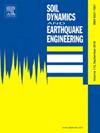鸡石山6.2级地震黄土液化流滑特征及机制
IF 4.6
2区 工程技术
Q1 ENGINEERING, GEOLOGICAL
引用次数: 0
摘要
一般认为,黄土不容易液化。然而,在2023年12月18日,中国甘肃省(35.70°N, 102.79°E)发生了6.2级地震,引发了距离震中约10公里的大规模黄土液化流滑坡,全长2.5公里。为了解其致灾机理,本研究通过实地调查和室内试验,获得了源区黄土的物理力学特性,并对饱和黄土的液化行为进行了表征。研究结果表明,强烈的地面运动、饱和的黄土和平缓的坡度共同形成了主要的动力、地质和地形条件。饱和黄土主要由粒径小于0.075 mm的粉土颗粒组成,约占其组成的92.2%。11m深度的饱和黄土在地震波作用下发生液化,峰值地加速度为0.40 g,但由于黄土独特的孔隙结构,液化过程中孔隙压力发展速率滞后于应变上升速率。大部分应变积累发生在地震活动高峰后的稳定阶段,而孔隙压力即使在振动停止后也会继续升高。研究结果为认识黄土液化诱发地震流滑灾害的成因提供了科学依据。本文章由计算机程序翻译,如有差异,请以英文原文为准。
Characteristics and mechanism of loess liquefaction-induced flow slide in Jishishan M6.2 earthquake, China
It is generally believed that loess is not prone to liquefaction. However, on December 18, 2023, a magnitude 6.2 earthquake occurred in Gansu Province, China (35.70°N, 102.79°E), triggering a large-scale loess liquefaction-induced flow slide spanning 2.5 km, approximately 10 km from the epicenter. To understand the disaster-causing mechanism, this study obtained the physical and mechanical properties of loess in the source area through field surveys and laboratory tests, and characterized the liquefaction behavior of saturated loess layers. The findings indicate that the strong ground motion, saturated loess, and gentle slope collectively contribute to the prevailing dynamic, geological, and topographic conditions. The saturated loess layer primarily comprises silt particles with particle sizes less than 0.075 mm accounting for approximately 92.2 % of its composition. The saturated loess layer at a depth of 11m was liquefied under the action of seismic waves with a peak ground acceleration of 0.40 g, however, due to the unique pore structure of loess, it is observed that pore pressure development rate lags behind strain rise rate during liquefaction process. The majority of strain accumulation occurred during a distinct post-peak stabilization phase following peak seismic activity while pore pressure continues to escalate even after vibration ceases. The results provide scientific insights into understanding the cause contributing to loess liquefaction induced-flow slide disasters due to earthquake.
求助全文
通过发布文献求助,成功后即可免费获取论文全文。
去求助
来源期刊

Soil Dynamics and Earthquake Engineering
工程技术-地球科学综合
CiteScore
7.50
自引率
15.00%
发文量
446
审稿时长
8 months
期刊介绍:
The journal aims to encourage and enhance the role of mechanics and other disciplines as they relate to earthquake engineering by providing opportunities for the publication of the work of applied mathematicians, engineers and other applied scientists involved in solving problems closely related to the field of earthquake engineering and geotechnical earthquake engineering.
Emphasis is placed on new concepts and techniques, but case histories will also be published if they enhance the presentation and understanding of new technical concepts.
 求助内容:
求助内容: 应助结果提醒方式:
应助结果提醒方式:


